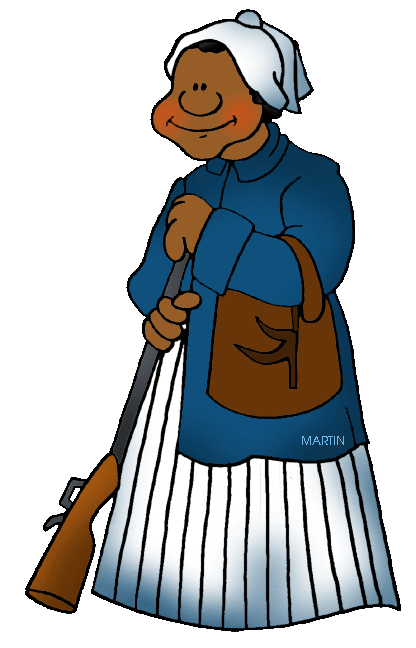
Slavery in America for Kids - Who was Harriet Tubman?
Harriet Tubman was an escaped slave herself. She was helped to freedom by the Underground Railroad. By then, it was no longer necessary to reach Canada. If a slave could reach Philadelphia, they would be free. After working for about a year in Philadelphia, saving money, Harriet Tubman managed to return to her former home in Maryland, where she had been a slave. She went there to help her husband escape and to bring him back with her to Philadelphia. But her husband had married someone else in her absence and did not wish to leave. She returned to Philadelphia, and decided to devote her life to helping other slaves escape.
She served as a conductor on the Underground Railroad for the next 10 years. Her route was moving fugitive slaves from Wilmington, Delaware to Philadelphia. It was the most dangerous route as it was the last leg on the Underground Railroad. By the time runaways reached Harriet, they were exhausted. They were easy prey for slave catchers. Harriet gave them hope. She shoved and pushed and carried them to freedom. Since slavers were out and about, seeking fugitive slaves between Wilmington and Philadelphia, Harriet knew she had to keep her runaways hidden from sight and sound. She carried opium with her to give to babies to keep them quiet. She carried a pistol and was not afraid to use it. Harriet Tubman helped more than 300 slaves to freedom along the Underground Railroad. Thanks to the abolitionist press, and their frequent stories about Harriet Tubman and the dangers she faced to help the plight of slaves, many people knew her name. By 1860, the South had put a bounty on her head of $40,000! Many slave catchers tried to earn that bounty, but no one ever caught her!
Harriet Tubman did more than lend her support to the Underground Railroad. In 1862, during the Civil War, she traveled to an island off the shore of South Carolina. The island and its residents were under the protection, by then, of the U.S. Army. The residents were slaves abandoned by their owner. They spoke their own language. They knew nothing about life on the mainland or in the rest of the country. They were very alarmed at all the Union soldiers who had descended on their island. Harriet had her hands full trying to gain their trust.
The first thing she did was build a wash house. She set up a business with the island women washing Army uniforms. She was paid by soldiers in both cash and goods. The island woman had no use for the cash, but they loved the goods. Harriet split up their earnings equally, taking only her share. She took her share in cash. She also went along with the Army on raids to the mainland, seeking slaves to rescue. One time, traveling with a gunboat, she brought back over 700 slaves and left several mainland plantations on fire. She was an amazing woman. No Union soldier ever tried to turn her in for the bounty, in part because Confederate money could not be used in the North and was losing value rapidly even in the South. But having someone wash their clothes until they were truly clean, free of lice and filth, that was worth buying!
By 1864, the year before the Civil War ended, Harriet Tubman decided to retire. She had saved enough money on the island, washing soldiers clothes, to pay for her needs for many years to come. She returned to her home in Auburn, New York. She lived there for the rest of her life.
What was the Underground Railroad?
The Underground Railroad Games and Activities for Kids
Frederick Douglass - the story of another escaped slave
For Teachers

Explore American History
For Kids and Teachers
Creating a New Nation
- New World Explorers
- Native Americans in Olden Times
- The 13 Colonies
- Road to Revolution
- The American Revolution
Creating a New Government
Western Expansion
- Jefferson and theNew Republic
- Louisiana Purchase
- Lewis & Clark
- War of 1812
- Monroe Doctrine
- Manifest Destiny
- The Oregon Trail
- Wagon Trains
- Pioneer Life & Frontier Life
- Trail of Tears
- The Alamo 1836, Texas Revolution
- Mexican - American War 1846-1848
- Gold Rush
Brink of the Storm and the Civil War
- Events Leading up to the American Civil War
- The Industrial Revolution
- American Civil War - 1861-1865
- People of the Civil War - Lincoln, Davis, Grant, Lee, Frederick Douglass, Harriet Tubman, Dred Scott and more
- 13th Amendment ending slavery forever
- Reconstruction, Carpetbaggers & Scalawags
- 14th & 15th Amendments
Growth in the West
The Nation Grows
World War I, The Great War
The Roaring 20s
The Great Depression
World War II
Slavery in America
Segregation for Kids - Civil Rights
US Holidays
QUIZZES - Interactive, with Answers for Student Review
For Teachers
Free for Classroom Use - American History Powerpoints and Presentations
American History Lesson Plans, Units, Activities, Projects for Teachers